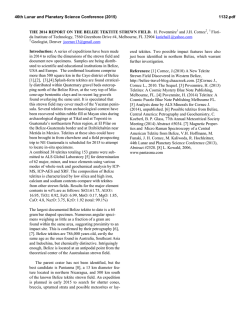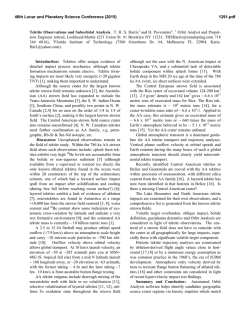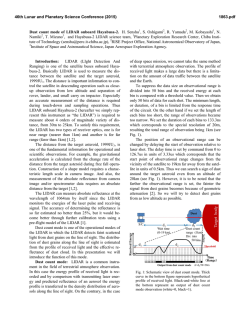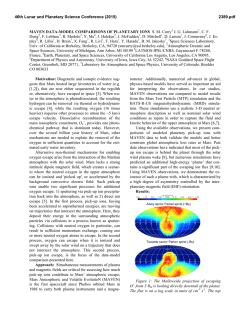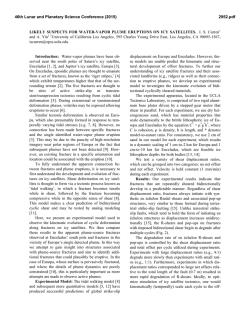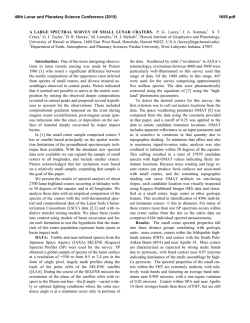
An Origin of Splash-Form Tektites in Impact Plumes
46th Lunar and Planetary Science Conference (2015) 2879.pdf AN ORIGIN OF SPLASH-FORM TEKTITES IN IMPACT PLUMES. John T. Wasson University of California, Los Angeles, CA 90095-1567, USA Introduction. Since about ~1960 the consensus view has been that splash-form tektites were formed during processes associated with the formation of impact craters. However, because Australasian (AA) splash-form tektites have 10Be contents similar to those in local soils, this model is no longer viable. There seems to be no way to form a crater which melts only the ca. 50-cm thick soil horizon.It is therefore useful to investigate other possible origins. I suggest that formation by melting dust entrained inside an impact plume is the best model. There was a glaciation when the AA tektites formed; field studies have shown deposits of aeolian dust. Thus a source of dust having the approximate grain size recorded in tektites was present, and it was likely well suited for entrainment by strong updrafts associated with a plume.. Splash-form and layered tektites. The AA tektites comprise two very different forms, Splash-form (or spinform) tektites have the well known teardrop, dumbbell and disk shapes; layered tektites have millimeter-size layering and fragmental shapes. The layered tektites seem to have formed as melt sheets, with the heat source attributed to radiation from a very large airburst [1]. Splash-form tektites and impact craters. The argument for forming tektites in impact craters mainly dates to the recognition that the Ries Crater and the nearby moldavites formed at about the same time ca. 15 Ma ago, consistent with formation in the same event. Flanged tektites. Many tektites in Australia and some from Indonesia show flanges produced by remelting when they reentered the atmosphere. To get from SE Asia to Australia, an optimum ballistic trajectory requires tektites to have left the atmosphere with a velocity greater than 6 km s-1, slightly less than orbital velocity at 100 km above the Earth’s surface. This high launch velocity is a major challenge for all models of tektite formation. Anisotropic distribution of tektites. Because of the high density of splash-form tektites in the NE part of SE Asia this must be the source region (ground zero). As shown in Fig. 1, they are mainly found south of ground zero. The field is mainly confined to an arc extending from 90 to 230 for vectors from an apex in the Gulf of Tonkin. Because the event occurred 0.78 Ma ago, tektites should have been preserved in most South Asian environments if the initial distribution was isotropic. It thus seems that ejection of material towards the north did not occur. Tektite formation from soils. Terrestrial 10Be (t½ = 1.5 Ma) is produced by cosmic rays, mainly in the stratosphere. It attaches to particles and eventually is removed from the stratosphere by turbulence associated with Fig. 1. Distribution of Australian microtektites from deep-sea cores (filled circles) and splash-form macrotektites [2]. Cores at open-circle locations did not bear tektites. Apex of the shaded angle is in the Gulf of Tonkin. the polar jet stream. The flux is higher at high temperate latitudes than at tropical latitudes. It is commonly removed from the troposphere by rain, and (because of the reactive nature of Be) largely remains in soils. Measurements of 10Be in AA tektites show (decay corrected) concentrations similar to those in soils of SE Asia [3]. This requires that tektites formed from recent soils with only minor (factor ~2) dilution by components having little or no 10Be. Most tektites are fully vitreous but they did not form a well-mixed fluid. As a result, the original grain size can still be recognized; a typical value is 40 m, similar to that in aeolian soils [4]. This also offers strong evidence that tektites formed from soils as opposed to bedrock. Formation of layered tektites as a melt sheet. Layered tektites can reach thicknesses of about 20 cm and the largest known fragments have masses of 24 kg. The most plausible model to explain the layering is flow, but some textural features may reflect turbulent deposition and volatilization of volatiles such as carbonates. The melt sheet was undoubtedly quite thin on average, perhaps a few mm thick. The depth would have varied depending on the local fallout of molten dust. The thickest tektites are inferred to have formed by flowgenerated accumulation in topographic lows. Tektites have relatively high contents of SiO2 (>650 mg/g), in part because these glasses are more resistant to weathering. To allow the flow necessary to form layered tektites the viscosity needs to be 50 poise or less. This requires temperatures >2200 K. To achieve this tempera- 46th Lunar and Planetary Science Conference (2015) ture by radiant heating this requires that the sky temperatures be much higher, probably 3000 K or higher. Glaciation source of the aeolian dust. At the time the AA tektites formed the Earth was close to a glacial maximum [5]. The amount of water stored as ice at the poles was very large and sea levels were low, perhaps by as much as 100 m. Winds are stronger and dust storms more common during glaciations. And a source of dust was at hand. The depth of the ocean is low in the Gulf of Tonkin and in the region south of Indochina. Although recent loess formation (e.g., near the Yellow River in China) originates from dust storms over northern deserts, a sizable fraction of loess commonly originates from nearby fine sediments (e.g., loess deposits on the east side of the southern part of the Mississippi River). As illustrated in Fig. 2, exposed seafloor in the Gulf of Tonkin could have been a major source of SE Asian loess. Fig. 2. Lighter shading shows exposed continental shelf near SE Asia during major glaciations. Adapted from [6]. Plume model: entrainment of porous aeolian dust deposits. Loose particles are entrained into and within plumes. Hailstones supported by updrafts can reach sizes of 15 cm. A plume above a region of loess deposits would entrain large quantities of dust. Within the plume the dust would be melted by radiation and, as a result of collisions and surficial adhesion, would agglomerate to sizes ranging up to several cm. The largest size was probably set by a steady state between growth by accretion of small particles and collision destruction when larger masses collided. Turbulence within the plume led to the spinning that produced the characteristic shapes (dumbbells, teardrops, disks). Most tektites would fall out locally. Only a trivial fraction was put into trajectories that carried them above the atmosphere. Plume model: multiple projectiles, oblique entry into the atmosphere. Compact projectiles make bowl shaped craters when they impact the Earth’s solid surface at cosmic velocities. Because there is no bowlshaped crater, the source was probably spread out over a relatively large region. The plume would be similar in many ways to the test of a high-yield nuclear weapon 2879.pdf near the surface of the Earth. The weak projectile broke up into many pieces, perhaps in part before it hit the atmosphere [1]. Most fragments, like the Tunguska object, lost all their kinetic energy in the atmosphere. However, a few larger (more strongly compacted and thus stronger) objects must have made it all the way to the Earth’s surface. I picture that the impact plume formed above a large region (>10 km in diameter) where many 10 to 30 m objects reached the ground and formed overlapping craters. It may be possible to explain the anisotropic distribution of tektites if the plume formed near the northern limit of the AA tektite field and was not vertical but inclined in the direction of the projectile trajectory. I suggest that this non-vertical expansion might occur if the projectile (or, better, the stream of small projectiles) entered the atmosphere from ca. 160 E of north (here called the south) and heated a cylinder of air surrounding its path. Although the traditional picture or plumes is that they rise perpendicular to the Earth’s surface, it seems possible that the roughly cylindrical trajectory path immediately started expanding, dominantly away from the surface of the Earth and also perpendicular to the center of the cylinder. The most probable entry angle for an accreting projectile is 45 and this might be about the right angle for launching the tektites. I have not attempted to model the physics but the generally lower density of the hot gas within the trajectory cylinder and it net velocity away from the surface seems capable to causing the primary expansion of the plume to follow in the same general direction. The extremely hot (perhaps initially >10000 K) air would gradually create a cone-shaped expansion of the plume that could account for the observed large (ca. 160) angle distribution of microtektites. The key question is whether such a plume could entrain tektites with masses of 250 g and launch them at velocities > 6 km s-1, as required to send them to Australia. Some microtektites were launched at velocities around 7 km s-1. Detailed modeling is needed to answer these questions. Summary. Properties of splash-form tektites are inconsistent with formation during the impact excavation of a bowlshaped crater. 10Be and other evidence require formation from near-surface soils. I suggest that they formed from soils entrained into a plume. Although most evidence stems from studies of Australasian tektites it appears best to assume that all splash-form tektites formed under the same, relatively uncommon, very dry conditions. The chief modeling challenge is to show that large (250-g) tektites can be accelerated out of the atmosphere at velocities >6 km s-1. References: [1] Wasson J (2003) Astrobiol. 3, 163. [2] Glass B. and Pizzzuto J (1994) JGR 99, 19075; [3] Ma et al. (2004) GCA 68, 3883; [4] Sun et al. (2002) Sediment. Geol. 152, 263; [5] Schneider et al. (1992) EPSL 111, 395. [6] Voris H. (2000) J. Biogeogr. 27, 1153
© Copyright 2025
